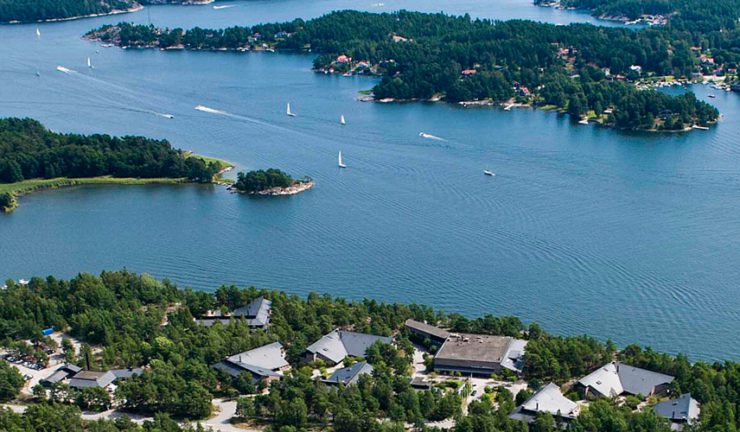History of Djurönäset
Djurönäset stood ready to receive its first guests in the autumn of 1979. PTK wanted to create the best possible conditions for training, and had organised an architectural competition. The winning design had been drawn by Anders Thalberg of the ELLT architectural agency (which subsequently became The White architects).
The competition entry was entitled “Frisk luft” (in English: “Fresh Air”) and was intended to stimulate creativity, a zeal for work, and well-being, based on the idea that we perform better when we are active and can breathe fresh air.
Seregården was built in 1980 to meet an ever-increasing demand. The building is named after Ingvar Seregard, Principal Secretary of PTK at the time. The need for suitable premises of high quality continued to grow, and thus a seventh building was added in the middle of the 1980s, completing the facility.
The buildings have, of course, undergone continual renovation, and architect Erik Ahlsén, Karina Björk and Per Öberg are some of the arhitects that has ben consulted for the work. The hotel rooms and meeting rooms are decorated with images taken from the surroundings, printed on linen, by artist Gudrun Walla.
Djurönäset has built up a long experience in everything from training courses, kick-off activities and management conferences to congresses with their associated arrangements and activities. Djurönäset is one of just over 100 facilities in Sweden selected by Svenska Möten – a conference booking company.
The hotel became a Nordic Eco labelled hotel as early as 2001, when the importance of working with and for the environment was realised. It was awarded security classification under the stringent requirements of SAFE Hotels in 2008.
- Djurönäset is now one of the largest conference facilities in Sweden with 274 bedrooms and 80 meeting rooms. It can accommodate 550 overnight guests at a conference, and can take groups of up 450.
- Djurönäset is located in the municipality of Värmdö, about 45 minutes by bus or car from central Stockholm.
- Visita, the branch organisation for the Swedish hospitality industry, has given four stars to Djurönäset, classifying it as “Superior”.
- Since 2018, Djurönset is owned by Dinera AB
History of Djurhamn
Djurönäset has a long and rich history. Djurhamn was first mentioned during the middle of the 15th Century when Sweden existed in a political union with Denmark and Norway under the Danish king, Kristian I – the man who Swedes call ‘The Tyrant’. During the 17th Century when Sweden was one of the most powerful nations in the world, Djurhamn became one of the country’s most important shipping harbours.
In 1623 the ship ‘Riksvasan’ sank on her mooring just outside Djurhamn. She still lies there today, 40m underwater although somewhat lighter after all the ‘souvenirs’ which have been collected by divers over the years. The shipwreck was a huge catastrophe, almost in the same league as the sinking of the ‘real’ Vasa in 1628.
Djurhamn is now a protected heritage site and is situated a few kilometres north of Djurönäset beside the church. Why not take a bicycle ride there, sit down for a while and gaze out over the Kanholmsfjärden (bay) and imagine all the ships that have passed through its waters? You are looking at what was for almost a thousand years Stockholm’s, and therefore Sweden’s, gateway to the world.
